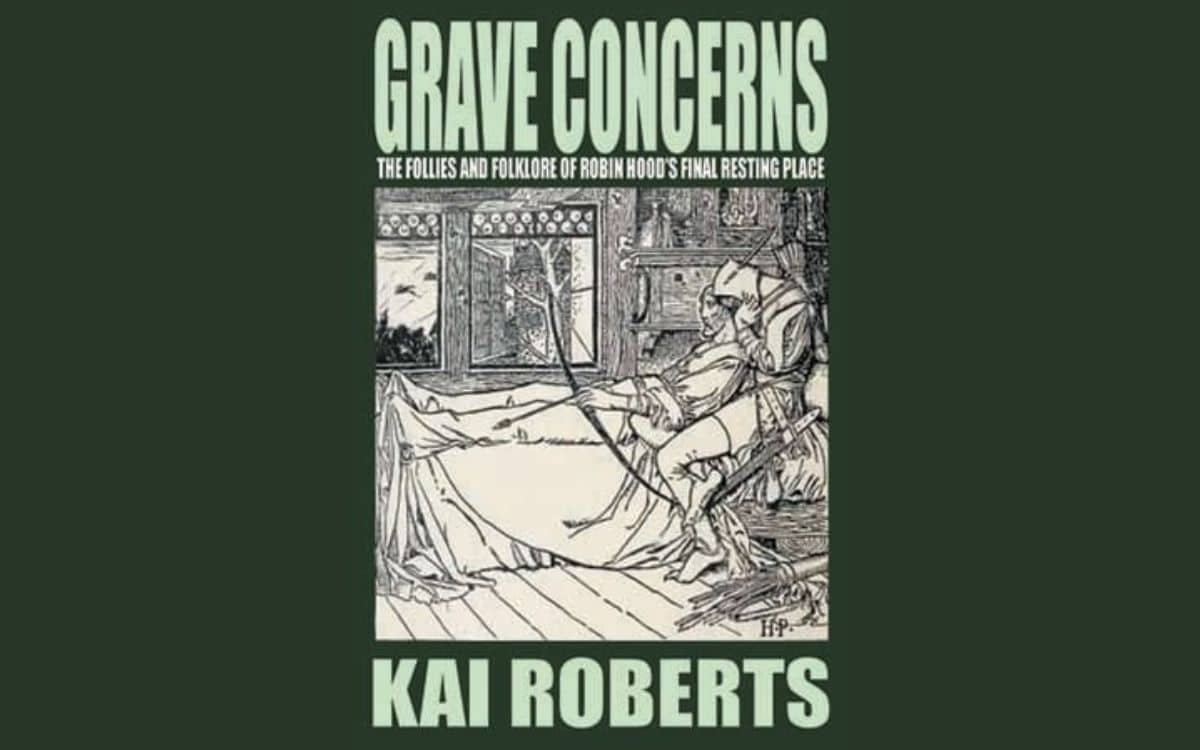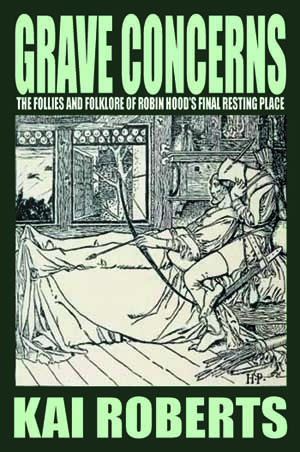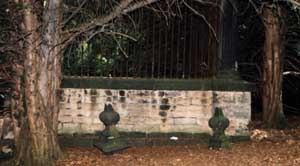Guest writer KAI ROBERTS, author of Grave Concerns: The Follies and Folklore of Robin Hood’s Final Resting Place, explains why it is so hard to nail down where the historical outlaw is actually buried
Whilst most people today associate the legendary outlaw Robin Hood with Sherwood Forest in Nottinghamshire, the place most consistently connected with his name from the earliest medieval ballads has been Kirklees Priory in the industrial heartlands of West Yorkshire.
The oldest surviving narrative sources record that after falling ill, the elderly Robin travelled to Kirklees Priory to receive medical attention from his cousin, the Prioress. However, in league with Sir Roger Doncaster—a local enemy of the outlaw—she betrayed her kin, for the harm he had done to the church.
Bloodletting was a common treatment for many ailments in the Middle Ages but after opening Robin’s vein, the Prioress abandoned her cousin and allowed him to bleed to death.
Accounts of his subsequent burial differ. In one version, the Prioress inters him by the side of the highway as a warning to other outlaws. In another, Robin uses his final strength to summon his comrade Little John, who he instructs to lay him to rest nearby.
Meanwhile, in romantic retellings of the story from the 18th Century onwards, Robin fires a last arrow from the Priory window and commands his friend to bury him where it falls.
Kirklees Priory was destroyed following the Dissolution of the Monasteries and the land subsequently occupied by the Armytage baronets. However, traces of the old Priory can still be seen, including a monument known as “Robin Hood’s grave”.
The legitimacy of the site is controversial and some writers have dismissed it as an 18th Century folly. Yet whilst the current enclosure was constructed in the 1700s, references to the site of the grave date back to the 1530s, hinting at its greater antiquity.
During the 20th Century, the Armytage family has consistently refused public access to the grave and the monument has been left to wrack and ruin. Today, it is an eerie sight; a mass of twisted railings and crumbling stonework rotting beneath a canopy of yew trees.
Since the late 1980s there has been an acrimonious campaign for greater public access led by the Yorkshire Robin Hood Society. It was also during this period that the grave acquired a darker reputation.
Stories had always circulated about the uncanny nature of the site: a 17th Century story recounts how a local knight attempted to use the grave-slab for his hearthstone, only to find that every night it was moved out of place by mysterious forces, forcing its return to its original location.
Then in the late 1980s and early 1990s, people began to witness the phantom of the murderess Prioress herself. One illicit visitor to the grave encountered “a wraith with red eyes, staring and horrible”, whilst another described “black nun’s robes flapping eerily while her eyes flashed red and venomous”.
These reports were exploited by Bishop Seán Manchester—who had famously investigated the Highgate Vampire two decades earlier—to suggest that a vampire was loose at Kirklees. He claimed the mode of Robin’s death had been vampiric and the unquiet spectre of the outlaw’s killer stalked the grave site still. This led to the gravesite becoming a new battleground in Manchester’s long-running feud with David Farrant, another former player in the “Highgate Vampire” saga.
As a result, it is difficult to say to what extent the paranormal experiences at Kirklees are genuine, and how much has been exaggerated and distorted to suit the agendas of interested parties. Yet one thing is certain: as long as the grave lies neglected and unseen, it will continue to attract a sinister reputation.
Kai Roberts is a freelance writer and researcher based in West Yorkshire with an interest in folklore, earth mysteries and the occult. He runs the blog “Ghosts and Legends of the Lower Calder Valley” and his book “Grave Concerns: The Follies of Folklore of Robin Hood’s Final Resting Place” can be purchased from here.
Bishop Seán Manchester responds to Robin Hood article
(Article originally published “Bishop Seán Manchester responds to Robin Hood article” in Spooky Isles on 20 September 2012)
BISHOP SEÁN MANCHESTER responds to the above Spooky Isles article written by Kai Roberts, author of Grave Concerns: The Follies and Folklore of Robin Hood’s Final Resting Place. The Roberts article referred to alleged vampire activity that was noted near the supposed grave of Robin Hood in Kirklees, Yorkshire.
Kai Roberts wrote in his article: “Then in the late 1980s and early 1990s, people began to witness the phantom of the murderess Prioress herself. One illicit visitor to the grave encountered ‘a wraith with red eyes, staring and horrible,’ whilst another described ‘black nun’s robes flapping eerily while her eyes flashed red and venomous.’ These reports were exploited by Bishop Seán Manchester-who had famously investigated the Highgate Vampire two decades earlier-to suggest that a vampire was loose at Kirklees.”
How is it possible for me to “exploit” reports essentially written about me and colleagues who accompanied me? There were, of course, reports of a medieval nun spectre stretching back to 1963 when Roger Williams encountered it while taking a stroll with a friend, but Kai Roberts identifies the 1980s and early 1990s, a time when I was enagaged in the investigation of the mysterious happenings and supernatural phenomena at and around Kirklees, West Yorkshire.
In my concise vampirological guide, The Vampire Hunter’s Handbook, page 29, is found: “A number of finger-width holes had been observed in the earth above the tomb in the winter of 1987. Animals drained of blood had been discovered in the immediate vicinity and nearby villagers had been obliged to call in priests to exorcise their homes of a malignant force.”
The description given of a wraith by Kai Roberts is taken verbatim from page 34 of my work The Vampire Hunter’s Handbook, so how could I possibly “exploit” my own recounting first-hand of what happened on the night of 22 April 1990?
Kai Roberts then proceeds to falsely allege: “This led to the gravesite becoming a new battleground in Manchester’s long-running feud with David Farrant, another former player in the ‘Highgate Vampire’ saga.”
Yet David Farrant did not engage in his publicity-seeking shenanigans concerning the Kirklees grave until 20 April 2005 (when some semblance of a pseudo-occultic “witchcraft” ceremony took place as night fell and cameras inevitably clicked). This latter-day occurrence was 15 years after my own presence and the aforementioned encounter by one of my colleagues with a wraith; by which time I had long since ceased to investigate or involve myself with the Kirklees situation.
I cannot help having the distinct impression that Kai Roberts is interested more in creating a sensational impression to promote his recent book about Kirklees rather than stick to what he knows to be accurate where I am concerned.
Kai Roberts made known to me prior to his book’s publication that he was going to cover the Highgate Cemetery happenings of forty or so years ago to provide some background about me. I was not at all comfortable with this proposition in view of the fact that he also intended to include David Farrant. There has been so much controversy and misrepresentation of such distant events and the part played in them by those concerned; so much so, that I regard this as an area best avoided. So, naturally, I find Kai Roberts’ involving me in his book and using my name in its promotion regrettable in the extreme.
I do not wish to be exploited or misrepresented by Kai Roberts who holds antipathetic opinions about my Faith (I am a devout English Catholic) which are bound to influence what he writes. Hence my considerable disappointment at witnessing the regurgitation of my name in factually inaccurate references in his article “Where is Robin Hood’s Grave?” on The Spooky Isles website.
Robin Hood was one of 10 Greatest English Folklore Characters You Need To Know.






There was not an acrimonious campaign by the YRHS with Lady Armytage, as there was simply dialogue between the yrhs and its wish to preserve the historical sites and allow for a fair method of access, and the kirklees landowner– and so all that got into the press was that access was usually denied and all plans to save the sites was ignored, this was simply the bare facts, though it was odd that any efforts to publisize the situation were always mysteriously derailed–most recently red monkey films– and the request by the YRHS to have a Christian blessing on the site refused on several occasions. Also the YRHS did not know about the Kirklees Vampire visit to the graveside until after it had taken place and the two famous psychic investigators invited to the area were not invited by the society, nor was the ley line survey commissioned by them.